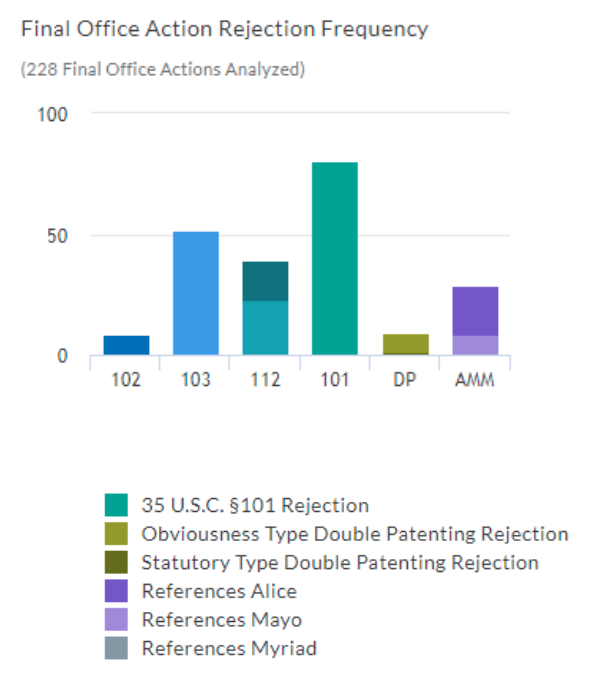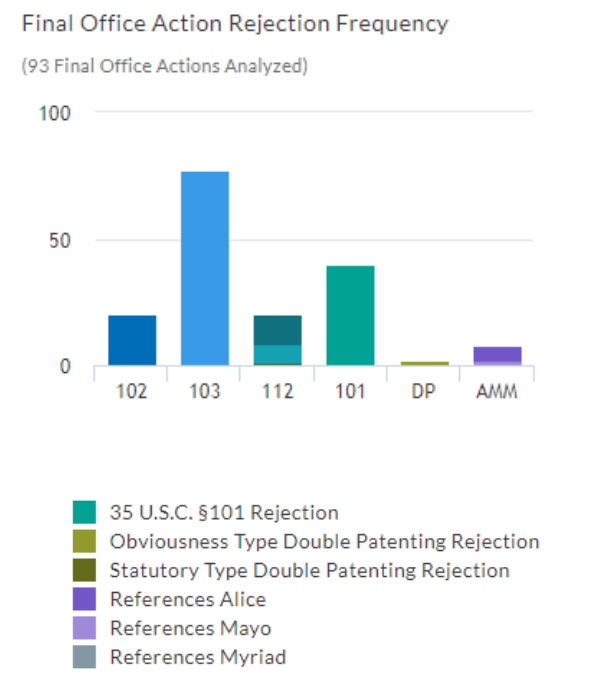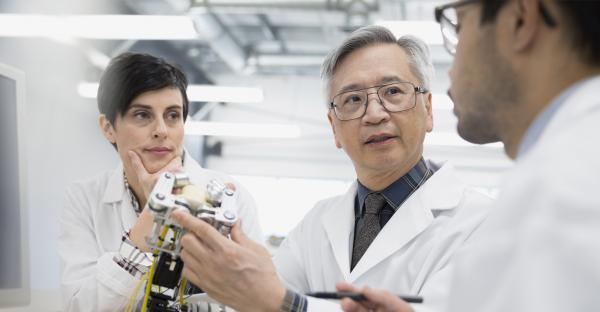Examining Art Units to Avoid Subject Matter Eligibility Challenges for Bioinformatics and AI-related Patents
Overview of Subject Matter Eligibility Challenges
Computer-based inventions – especially in the machine learning (ML), bioinformatics, and artificial intelligence (AI) fields – are susceptible to subject matter eligibility challenges. Subject matter eligibility challenges may prevent a patent application from being granted by the United States Patent and Trademark Office (USPTO) and may even be asserted to invalidate a patent post-grant. Subject matter eligibility challenges include categorizing the computer-related invention as an abstract idea, which includes mental processes (concepts capable of being performed on pen and paper), methods of organizing human activity (such as managing interactions between persons), and mathematical concepts.
In recent years, the Federal Circuit has implemented a multi-step test to determine whether patent claims would survive a subject matter eligibility challenge. In some cases, the Federal Circuit has upheld the validity of claims reciting an abstract idea when the claims integrate the abstract idea into a practical application or recite additional elements that amount to significantly more than the abstract idea. Similarly, the USPTO implements a similar multi-step test with various guidelines to determine whether patent claims in an application will survive a subject matter eligibility rejection. Nevertheless, 101 jurisprudence remains unsettled in regards to the key determining criteria and is continually evolving with new guidelines and emerging case law. As a result, the fate of bioinformatics and machine learning-based patents and patent applications remains uncertain.
As we previously discussed in Patenting Considerations for Artificial Intelligence in Biotech and Synthetic Biology Part 1, computer-based applications for inventions covering a gamut of life science disciplines – from sequencing and functional genomics to drug design, discovery, and testing – have realized tremendous benefits due to the use of machine learning and AI. But the patent rights protecting these advanced inventions are susceptible to the same subject matter eligibility vulnerabilities mentioned above.
Subject Matter Eligibility Challenges in AI and Bioinformatics
Many ML, bioinformatics, and AI patents face an uphill battle for patentability due to the use of computer systems and algorithms, and the rapidly evolving law surrounding subject matter eligibility. These computation-heavy areas face subject matter eligibility challenges, especially for their ML features or proximity to mathematical calculations.
For example, the Federal Circuit issued a decision that manifests the troubling eligibility landscape in the fields of machine learning and bioinformatics. In In re Board of Trustees of the Leland Stanford Junior Univ., No. 2020-1288 (Fed. Cir. Mar. 25, 2021), the Federal Circuit affirmed the rejection of the patentability of claims directed to computerized methods to generate genetic data. Here, Stanford sought to patent claims directed to a “computerized method for inferring haplotype phase in a collection of unrelated individuals” that created “new data” with the use of specific rules and machine learning techniques. These machine learning techniques included steps such as building a data structure describing a Hidden Markov Model, repeatedly randomly modifying at least one of the imputed initial haplotype phases, and automatically replacing an imputed haplotype phase. Id. at 4-5.
The Federal Circuit held that the claims did not “involve practical, technological improvements extending beyond improving the accuracy of a mathematically calculated statistical prediction.” Id. at 10. Additionally, the Federal Circuit found that “the recited steps of receiving, extracting, and storing data amount to well-known, routine, and conventional steps taken when executing a mathematical algorithm on a regular computer,” and the claims recite generic computer components that were in no way “specialized.” Id. at 12. As such, Stanford’s patent application for its computerized method for inferring haplotype phase did not get granted as a patent. At the time of publication, the court proceedings have terminated for this patent application.
As previously discussed here and here, there are a number of ways to mitigate the likelihood of a subject matter eligibility rejection. For example, an effective drafting technique includes adding explicit descriptions in the specification that identifies specific industries or applications where the AI may be particularly useful and explaining AI’s advantages over existing systems and processes.
In this article, we discuss another technique that includes drafting a patent application for placement into a specific art unit, which is possibly one of the most important drafting considerations that few patent practitioners think about. This article provides insight to USPTO art units to reduce the likelihood of abstract idea attacks in the first place for your ML, bioinformatics, AI, and computational patent.
Art Units Covering Technologies Related to AI and Bioinformatics
The USPTO assigns each U.S. patent application to one of many art units, which are organizational units of technology subclasses. Some art units at the USPTO may behave more aggressively than others in asserting subject matter eligibility challenges. Let’s look at art units 1631 and 2129 to compare the aggressiveness of different art units and their assertiveness relating to subject matter eligibility challenges.
1631 Art Unit
Field: Molecular Biology, Bioinformatics, Nucleic Acids, Recombinant DNA and RNA, Gene Regulation
At a glance:
- 59.7% allowance rate
- 718 allowed patent applications in past 5 years
- 485 abandoned applications in past 5 years
- 80.7% of abandoned applications within the past 5 years had a 101 rejection at the final office action
Rejections in Final Office Action of Abandoned Applications in Art Unit 1631

2129 Art Unit
Field: Artificial Intelligence & Miscellaneous Computer Applications
At a glance:
- 82.5% allowance rate
- 832 allowed patent applications in past 5 years
- 176 abandoned applications in past 5 years
- 39.8% of abandoned applications within the past 5 years had a 101 rejection at the final office action
Rejections in Final Office Action of Abandoned Applications in Art Unit 2129

Art unit 1631 tends to cover technologies related to molecular biology, bioinformatics, and gene regulation. Art unit 2129 covers artificial intelligence and miscellaneous computer technologies. As such, it is possible that the higher number of 101 rejections in the 1631 art unit is attributable to art unit 1631 encountering many applications directed toward a naturally occurring substance and/or a law of nature. Nevertheless, comparing the aggressiveness of the two art units, art unit 1631 appears to be more aggressive in asserting 101 rejections with 80.7% of abandoned applications within the past five years having a 101 rejection at the final office action. In contrast, art unit 2129 tends to be less aggressive at asserting 101 rejections with 39.8% of abandoned applications within the past five years having a 101 rejection at the final office action. Additionally, art unit 2129 has a much higher allowance rate than art unit 1631. The foregoing data suggests a ML-centric or bioinformatics patent is more likely to go abandoned for subject matter ineligibility in art unit 1631 than art unit 2129.
The comparison between art unit 1631 and art unit 2129 is salient to patent practitioners for a number of reasons. First, the historical examination outcomes for these art units reveal which one is friendlier towards AI-based applications. The number of applications in each art unit that were abandoned due to a 101 rejection is indicative of the difficulty of overcoming a 101 rejection in each art unit. Second, prior to filing a patent application, patent practitioners may wish to adjust their claim term usage, title, and abstract in the specification in an effort to direct the patent application to a more favorable art unit. Although there is little transparency in how the USPTO sorts patent applications into different art units, the technical field, abstract, and claim language of a patent application are likely factors considered during this process. Preemptive efforts to route a patent application to a more favorable art unit may be especially worthwhile because once a patent application is assigned to an art unit, the USPTO offers no recourse for reassigning the application to a different art unit. As such, identifying examination outcomes in each art unit before drafting a patent is knowledge to be leveraged as a practiced patent practitioner drafts a ML, bioinformatics, or AI-related patent application.
Perhaps the many roadblocks Stanford’s patent application faced through prosecution may be tied to the application’s assignment to art unit 1631. In the case of Stanford’s patent application for its computerized method for generating genetic data, the application was likely to have been assigned to art unit 1631 due to language such as “the field of computer diagnostics” and “methods for analyzing a genome.” Furthermore, the USPTO may have taken into account language in the claims’ preambles including “computerized method for interpreting genetic data” and “processing unit to interpret genetic data” in its decision to assign Stanford’s application to the 1631 art unit. Additionally, the abstract is focused on how an algorithm performs optimization on haplotypes. As such, there were multiple areas (e.g., the field of invention, claims, and abstract) that contained language for computational analysis as being involved in analyzing genomes and genetic data.
Takeaways
Subject matter eligibility challenges are here to stay, especially for computer-based bioinformatics and AI-related patent applications. The risks of receiving subject matter eligibility challenges can be mitigated by comparing examination outcomes in each art unit and then drafting patent applications to target favorable art units. Drafting techniques include modifying the claims, abstract, and title to target a favorable art unit. Drafting an application for placement into a specific art unit can be an important consideration in patent preparation. Once an art unit is assigned to your patent application, you cannot have the application reassigned to a different art unit. Practitioners should therefore be mindful while drafting the specification to consider an art unit to avoid prosecution landmines down the road, thereby enhancing the likelihood of a patent grant.
To learn more from the Mintz IP team, follow us on LinkedIn and check out our Exclusive Rights podcast.




